This Filipino Chicken Adobo recipe has tender, juicy chicken cooked in a tangy, intensely-flavorful sauce that is quick to throw together and delicious served over white fluffy rice.
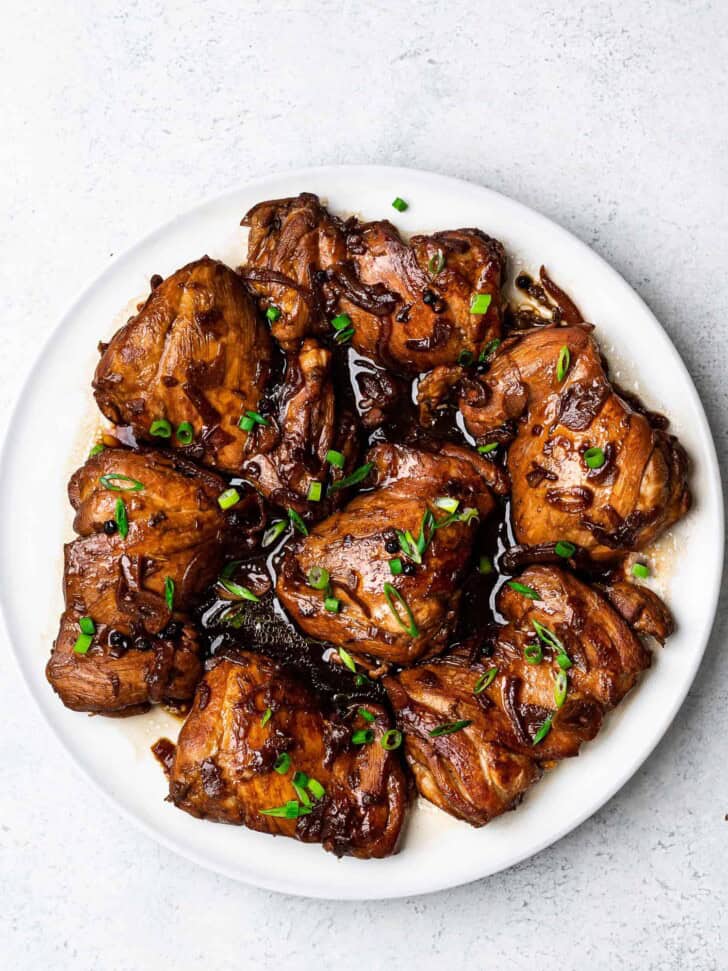
Brace yourself for a flavour bomb of tangy-salty deliciousness — this classic Filipino chicken adobo dish is going to knock your socks off. Chicken thighs are simmered in a silky, peppery, sour gravy that is made up of mostly vinegar and soy sauce. It takes no time to throw together and the cooking time of 25 minutes makes this a fabulous weeknight dinner.
About Filipino Chicken Adobo
Chicken adobo is the unofficial national dish of the Philippines. The word adobo is derived from the Spanish word adobar which means “to marinate”. But in the Philippines, adobo refers to both the process of marinating food with a predominantly vinegar base, as well as the finished dish.
When I first heard of Filipino chicken adobo I thought it would be similar to the Dominican pollo guisado that I grew up eating. It does have some similarities, Dominicans always marinate chicken in vinegar to “wash” it or to help tenderize it. But I soon found out Filipino chicken adobo is a completely different beast. The chicken is cooked in vinegar—LOTS of vinegar—and equal parts soy sauce. Garlic, onions, water, peppercorns, bay leaves, and a smidge of sugar help round out the sharp acidity of this unique and enticing dish.
Like all classic dishes, many variations exist depending on the cook and the region. Chicken is the most classic protein used with adobo sauce but pork, squid, and sometimes vegetables are also used. The consistency of the sauce can also vary; some people like it cooked a little longer so the sauce will reduce to a silky, sticky glaze. Others prefer to have more sauce so leave it thinner to douse over their food. This recipe leans towards the latter, but feel free to add less liquid if you prefer a more reduced sauce.
I have been making chicken adobo for many years, always good but not quite perfect. Then I found a recipe for it in the “Filipino Cookbook” by Miki Garcia that included onions. Not a traditional ingredient in most chicken adobo’s but to me, it felt like suddenly all the flavours became more balanced.
No matter the variation, a Filipino adobo sauce should always be characterized by a strong, yet enticing briny punch of vinegar and soy. I think you’ll love this version I share with you here.
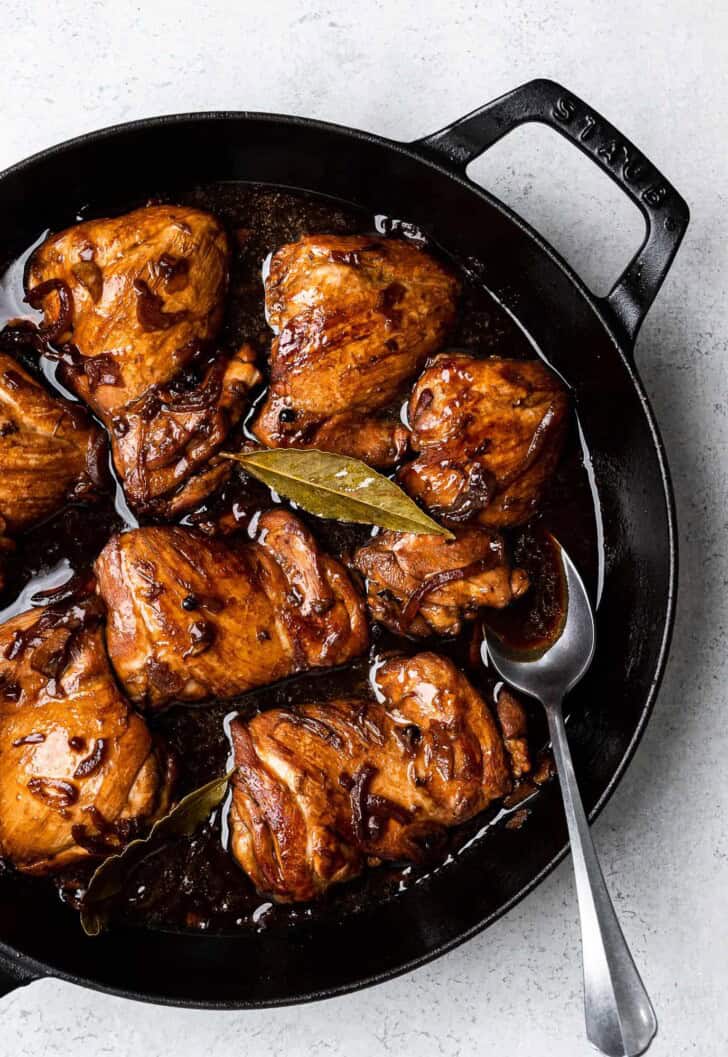
What Does Filipino Chicken Adobo Taste Like?
Heaven, if you ask me. But to be more precise, it is a dish that is intensely savoury and tangy with just a hint of sweetness. If you taste the sauce before it reduces, it will be unpleasantly sour. But as it cooks, the flavours mellow and become less sour.
Though bone-in chicken is traditionally used for this dish, I prefer to use chicken thighs. Cooked in the punchy sauce they become fork-tender and quite literally melt in your mouth. It is a beautiful dish to enjoy with your family and most definitely would be a hit if served to guests.
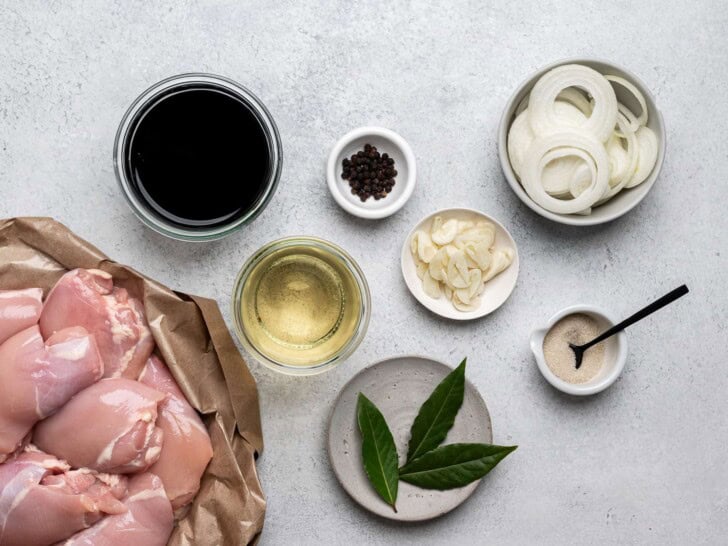
Ingredients And Notes
- Boneless skinless chicken thighs – You can use bone-in chicken pieces if you prefer but this recipe does not work well with chicken breast. They simply will not absorb the sauce properly and will dry out before the sauce has a chance to thicken and glaze.
- Vinegar – I like to use rice vinegar but plain white vinegar will also work if you use less. See below for more information on which vinegar is best for chicken adobo.
- Light or low-sodium soy sauce – Because of the amount of soy sauce being used, make sure to use a soy sauce with reduced sodium or it will be very salty. Instead of soy sauce, you can also use coconut aminos. Don’t use dark soy sauce which is completely different than regular soy sauce.
- Onion and garlic – Not all chicken adobo recipes include onions but I find their sweetness creates a nice balance of flavours in this dish. You can leave the onions out if you wish but the garlic is essential in chicken adobo.
- Peppercorns – The peppercorns are also a very essential ingredient in chicken adobo. They soften slightly when cooked but if you don’t like the idea of biting into a peppercorn just use coarse cracked pepper.
- Sugar – I often leave it out but if you are using regular vinegar, you will need just a few teaspoons. I like to use can or coconut sugar but brown or white will also work.
- bay leaves – Fresh bay leaves are preferred for this recipe but if you can’t find them use dried.
Green onion – Optional for garnish.
Suggested Variations
Though incredibly easy and straightforward to make, a Filipino adobo sauce relies on the perfect balance of flavours. If you haven’t made it before, I encourage you to follow the recipe as written at least once before making any adjustments. Here are a few variations you might enjoy:
-
- Use a different protein: I love this recipe with tofu! Simply drain and dry the tofu then cut into thick slices. Sear the tofu slices on both sides then proceed with the recipe. You can also use chopped up pork shoulder, squid, or even shrimp. Just make sure to adjust cooking times for more delicate protein.
- Make it with veggies: Slabs of cauliflower or chopped eggplant would be excellent vegetables to cook in this Filipino adobo sauce. You can even combine the two or add sugar snap peas, edamame, and broccoli florets – yum! I have also made it with just mushrooms (give this recipe a try) which I absolutely love.
- Add coconut milk: Some Filipino adobo recipes call for coconut milk. I haven’t tried it but I imagine it would be quite delicious. Here’s what I would do: Add 1 cup coconut milk but reduce the vinegar and soy each by 1/4 cup. Add the 1/2 cup of water only if necessary.
- More garlic: Filipino adobo is made with lots of garlic. I went middle ground but some recipes double it so if garlic is your jam, go ahead and add more!
- Add some heat: The peppercorns add minimal heat so if you want a spicier adobo sauce, add a few chopped up bird’s eye chilis or some red pepper flakes.
How To Make Filipino Chicken Adobo
Marinating the chicken in the vinegar and soy sauce is recommended but I don’t find it essential. I usually marinate it for about 20 minutes while I start making the rice and chopping the veggies. If you do plan ahead, go ahead and marinate it for 1 hour or overnight.
Here is the step-by-step to make this easy dish:
- In a large bowl, combine the vinegar, soy sauce, and peppercorns. Add the chicken thighs and marinate for at least 20 minutes or up to overnight.
- Heat oil over medium-high heat in a large skillet or pot. Remove chicken from the marinade allowing most of the marinade to drip back into the bowl (reserve the marinade) and place the chicken in the hot pan. Cook undisturbed for 2 to 3 minutes, or until just a bit brown and golden. Flip and cook for only 2 more minutes—do not cook through. Transfer chicken to a large plate.
- Reduce heat to medium-low and if necessary, add remaining oil to the pan. Add the onions and garlic and cook until garlic is fragrant and slightly brown, about 2 minutes. (The onions do not need to be brown).
- Add the reserved marinade, bay leaves and sugar and bring it to a rolling boil. Once boiling, lower the heat to medium and simmer for 5 minutes.
- Nestle in the chicken thighs, smooth side down. Lower heat to a simmer, and cook, uncovered, for 10 minutes. Flip the chicken thighs and continue to simmer, uncovered, for 10 to 15 minutes, or until sauce has reduced by at least half. At this point, if the sauce doesn’t seem thick enough, remove the chicken to a plate and continue to cook the sauce until it reduces to your desired consistency. I like it a bit glaze-y but not so thick that I lose too much sauce. Return chicken back to the skillet to warm slightly, if necessary.
- Serve immediately with fluffy white rice, passing around extra adobo sauce at the table.
Note: It will seem like too much liquid at first, but trust, if you followed the recipe as written the sauce will reduce and it will thicken. If you used a deep pot to make the chicken adobo, it will take longer to reduce.
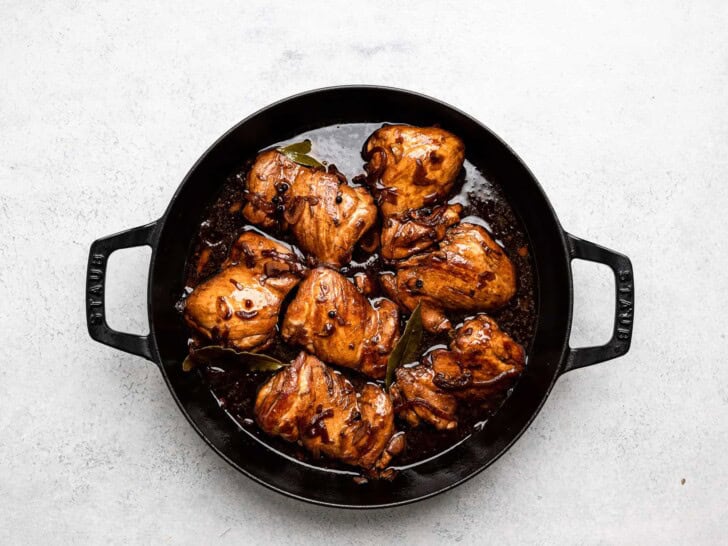
Best Vinegar For Chicken Adobo
A Filipino cane vinegar is traditionally used to make adobo sauce. It is sweeter and milder than regular white vinegar. If you feel like seeking it out, Datu Puti is a brand that can be found at most large Asian markets. In the Kitchener-Waterloo area you can find it here.
That said, I prefer to use (unseasoned) rice vinegar which I always have in my pantry. In a pinch you can also use apple cider vinegar or white vinegar but because these vinegars are more acidic in taste, you should reduce the amount by 1/4 cup. In addition, it is important to note that if you don’t use a cane vinegar, the adobo will need a few teaspoons of sugar. This will not make the dish taste sweet at all. It will just help tame the acidity of the vinegar.
FAQ’s
Do I have to brown the chicken?
This one is tricky. Many Filipino cooks add their chicken to the adobo mixture without browning it first. I have tried it and it’s fine. But truly, it is best to give the chicken a quick sear for both colour, presentation, and a little more flavour.
Because we are using skinless chicken pieces, the process is less messy and takes only a few minutes.
Should I use a skillet or a pot?
You can use a Dutch oven or deep pot but a large skillet works best here because the sauce will reduce more quickly. Just make sure the skillet is deep and wide enough to fit the chicken and sauce. If using a deep pot, I recommend you reduce the amount of vinegar and soy sauce by 1/4 cup each.
Why did my chicken adobo taste too vinegary?
Filipino chicken adobo is supposed to have a strong, pungent vinegar taste. That said, if you follow the recipe tips on using the right vinegar, it should be nicely balanced and not abrasive. White vinegar and apple cider vinegar will be a lot stronger tasting than rice vinegar so if using either of those, make sure you add a little more sugar, and/or reduce the amount of vinegar by 1/4 cup.
Why did I end up with too much liquid?
It is important that you use the right amount of meat to liquid. If you are using less than 2 1/2 pounds of chicken, I recommend you reduce the amount of vinegar and soy sauce by 1/4 cup each. Otherwise, you may end up with too much liquid to chicken ratio. In addition, a skillet versus a deep pot, will ensure the liquid can thicken, and evaporate, more quickly.
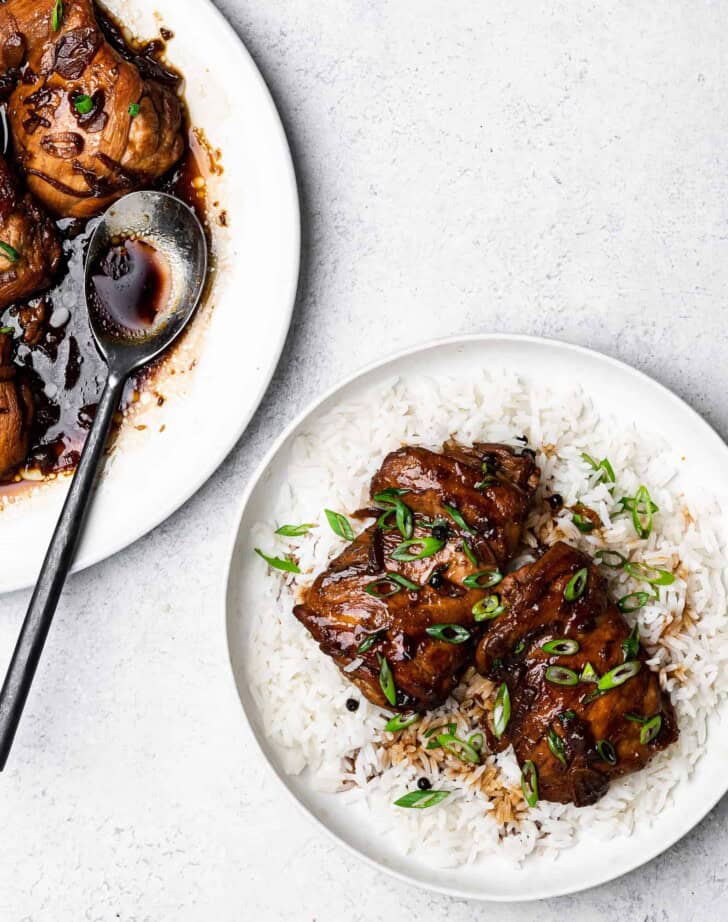
Serving Suggestions
Fluffy white rice is the classic side to serve with Filipino chicken adobo. Or, even better, serve it with this divinely creamy coconut rice. The mild sweetness of the coconut rice helps temper both the salinity and the acidity of the adobo sauce.
For a veggie side, we almost always have it with a cooling cucumber/avocado salad. Sprinkle everything with sliced scallions and trust me, you’ll be making this dish again and again.
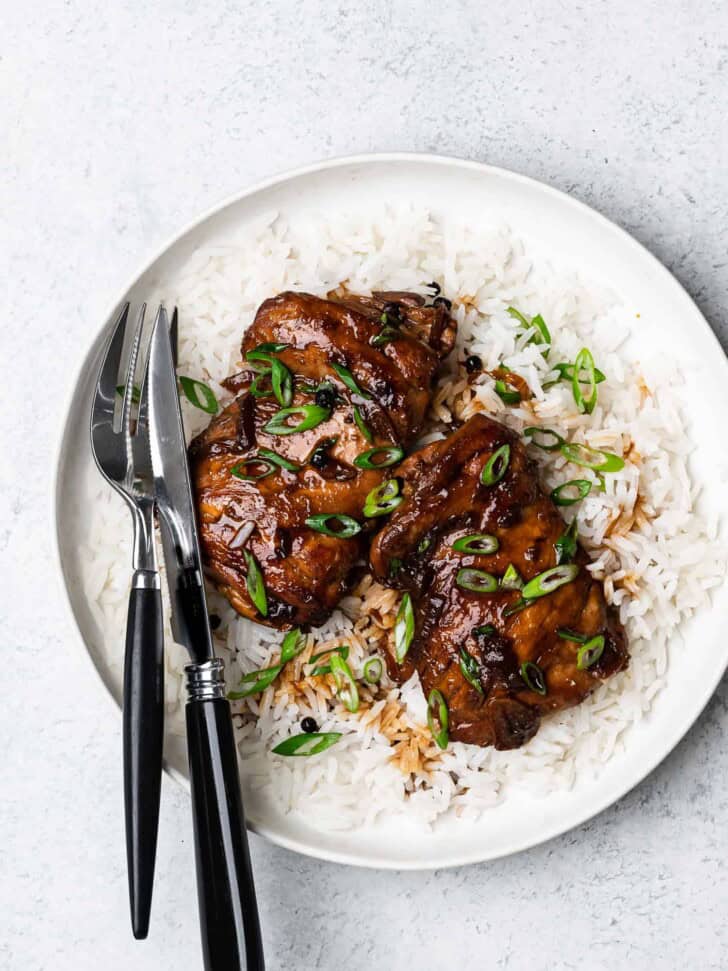
Make Ahead And Store
Filipino chicken adobo is one of those dishes that improves with time. So delicious the next day, I always make plenty so it is more than a one-meal dish. Leftovers also freeze really well.
To refrigerate or freeze: You can make the entire dish a few days ahead, or make a few meals out of it. Once the chicken adobo has cooled, place the chicken pieces in an air-tight container and pour the sauce over it. Refrigerate for up to 5 days or freeze for up to 2 months.
More Delicious Chicken Thigh Recipes To Try
- Instant Pot Chicken Thighs (Fresh or Frozen)
- Baked Lemon Chicken Thighs
- Thai Yellow Chicken Curry (Baked or Stovetop)
- Grilled Lemongrass Chicken
If you give this Filipino Chicken Adobo recipe a try, please feel free to leave a comment and/or a star rating below. We appreciate and welcome all your feedback. Thank you!
Filipino Chicken Adobo
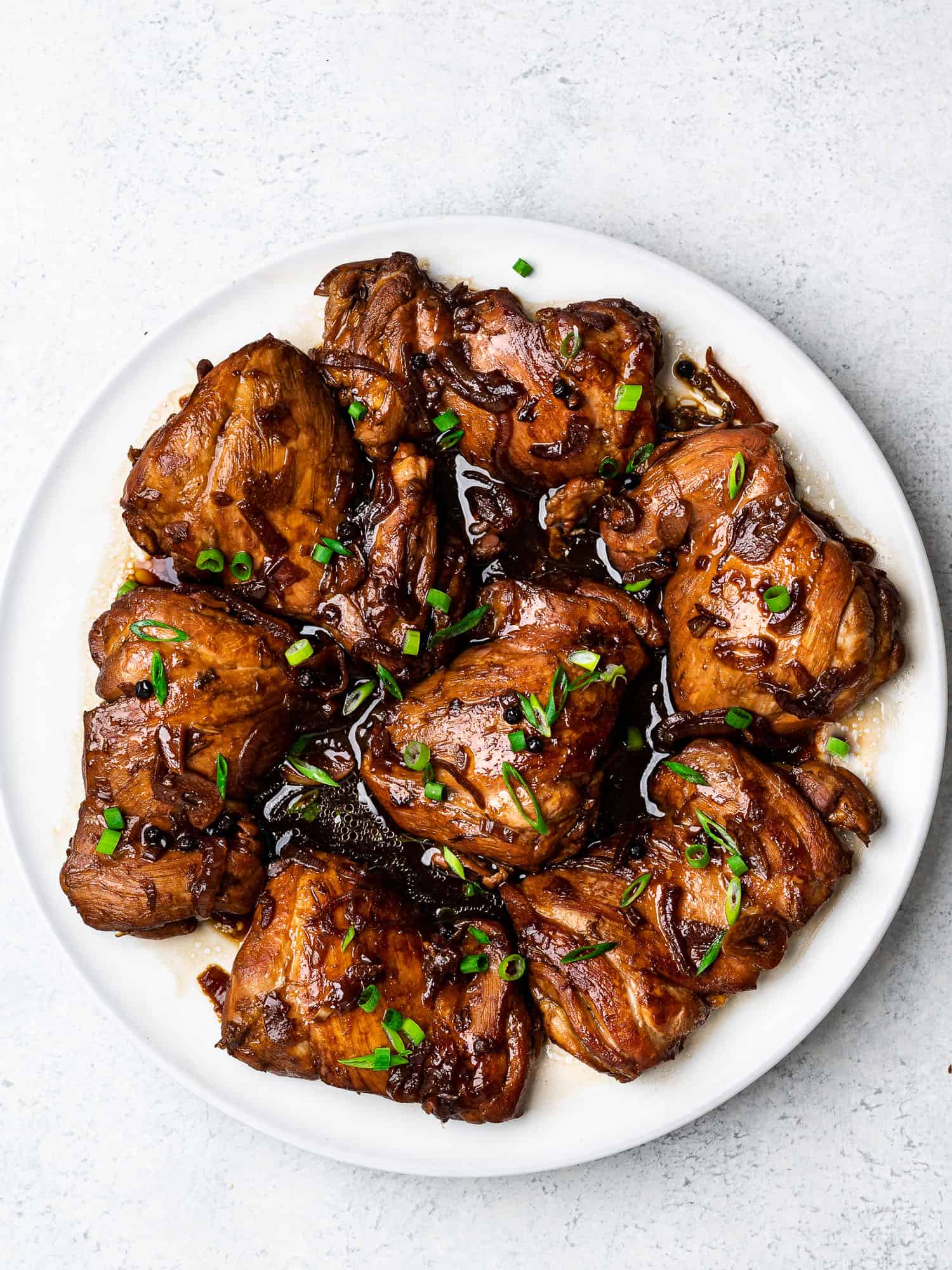
Ingredients
- 3/4 cup rice vinegar (*see notes)
- 3/4 cup light or low-sodium soy sauce (*see notes)
- 1 teaspoon black peppercorns
- 2 1/2 pounds boneless skinless chicken thighs
- 2 tablespoons neutral oil, such as avocado oil, divided
- 1 medium yellow onion, thinly sliced
- 5 cloves garlic, thinly sliced or minced
- 3 bay leaves (preferably fresh)
- 2 teaspoons cane, brown, or white sugar (*omit if using Filipino cane vinegar)
- 4 green onions, thinly sliced
- white rice for serving
Instructions
- In a large bowl, combine the vinegar, soy sauce, and peppercorns. Add the chicken thighs and marinate for at least 20 minutes, or up to overnight.
- Heat 1 tablespoon oil over high heat in a large skillet or pot. Remove chicken from the marinade allowing most of the marinade to drip back into the bowl (reserve the marinade). Place the chicken, smooth side down, in the hot pan. Cook undisturbed for 2 to 3 minutes, or until just a bit brown and golden. Flip and cook for only 2 more minutes—do not cook through. Transfer chicken to a large plate.
- Reduce heat to medium-low and add the remaining 1 tablespoon oil to the skillet. Add the onions and garlic and cook until garlic is fragrant and slightly brown, about 2 minutes. (The onions do not need to be brown).
- Add the reserved marinade, bay leaves and sugar and bring to a rolling boil, scraping up any browned bits that may have stuck to the bottom of the pan. Once boiling, lower the heat to medium and simmer for 3-4 minutes.
- Nestle in the chicken thighs, smooth side down. Lower heat to a simmer, and cook, uncovered, for 10 minutes. Flip the chicken thighs and continue to simmer, occasionally spooning sauce over the top of the thighs, for 10 to 15 minutes, or until sauce has reduced by at least half.
- At this point, if the sauce doesn't seem thick enough, remove the chicken to a plate and continue to cook the sauce until it reduces to your desired consistency. I like it a bit glaze-y but not so thick that I lose too much sauce. Return chicken back to the skillet to warm slightly, if necessary.
- Serve immediately with fluffy white rice, passing around extra adobo sauce at the table.


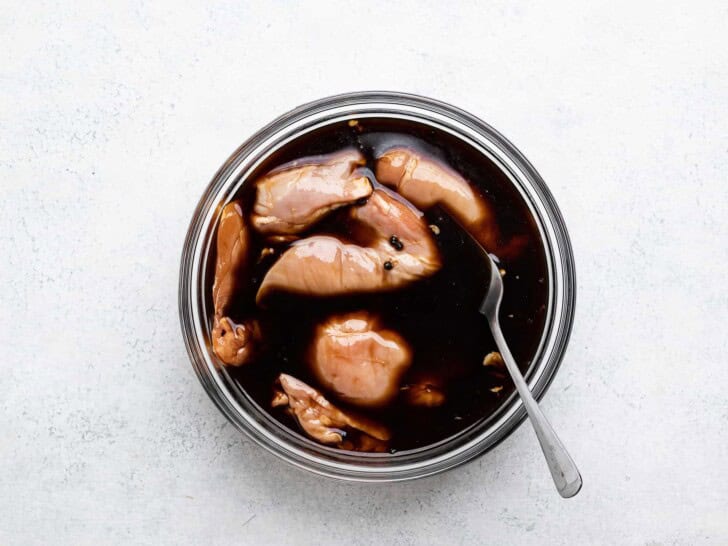
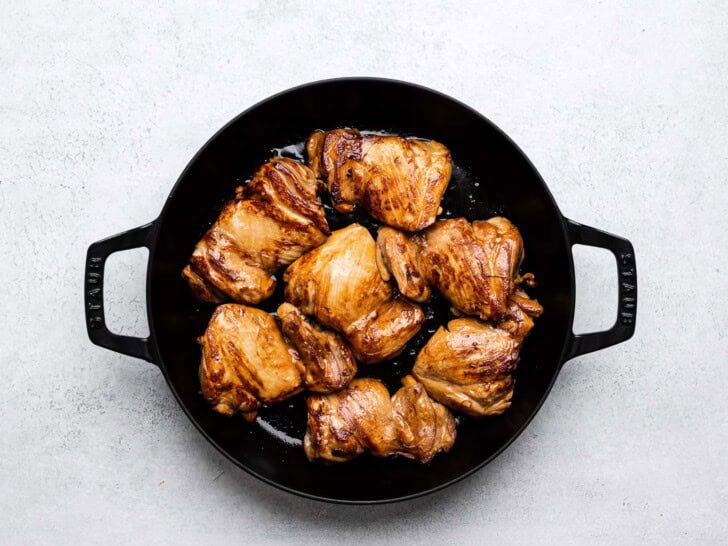
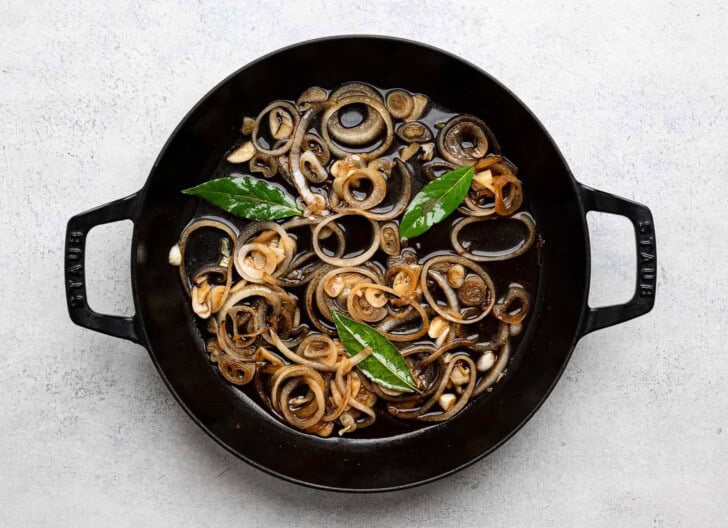
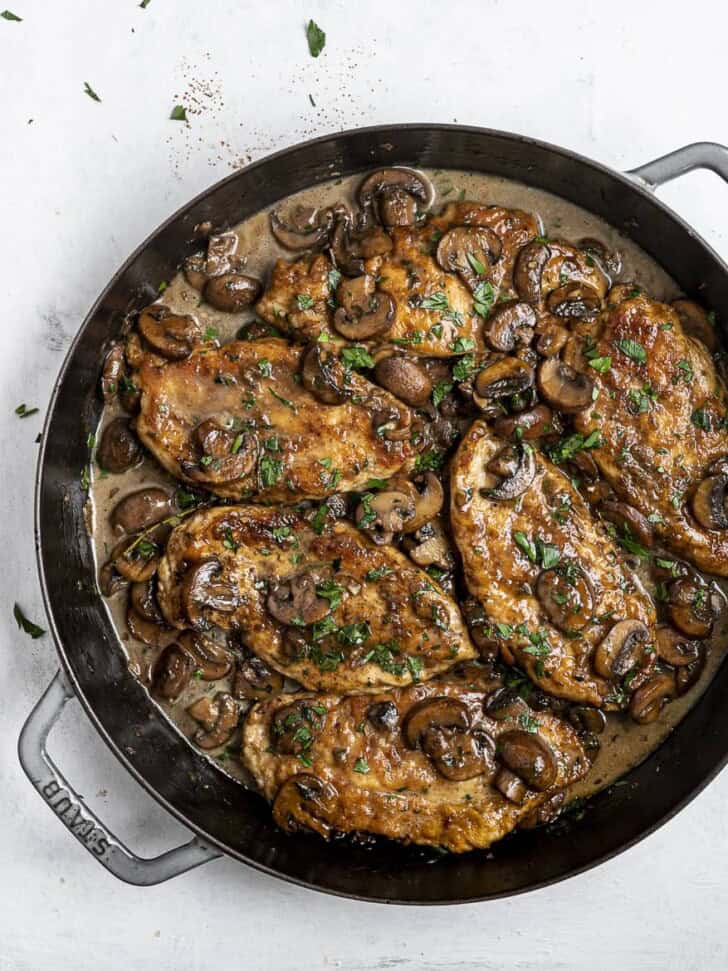
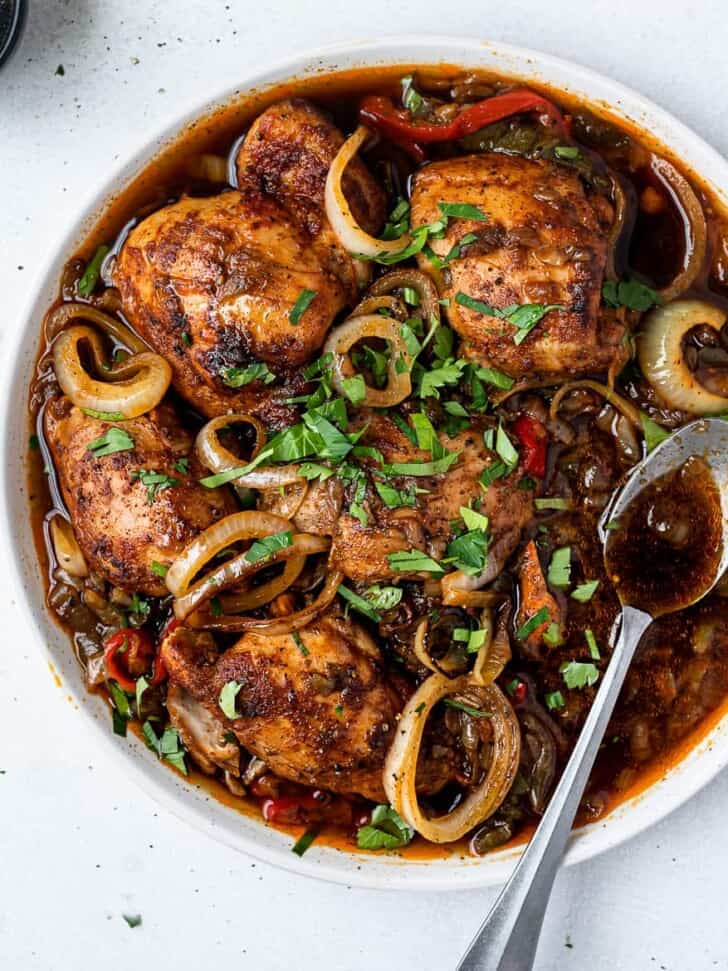
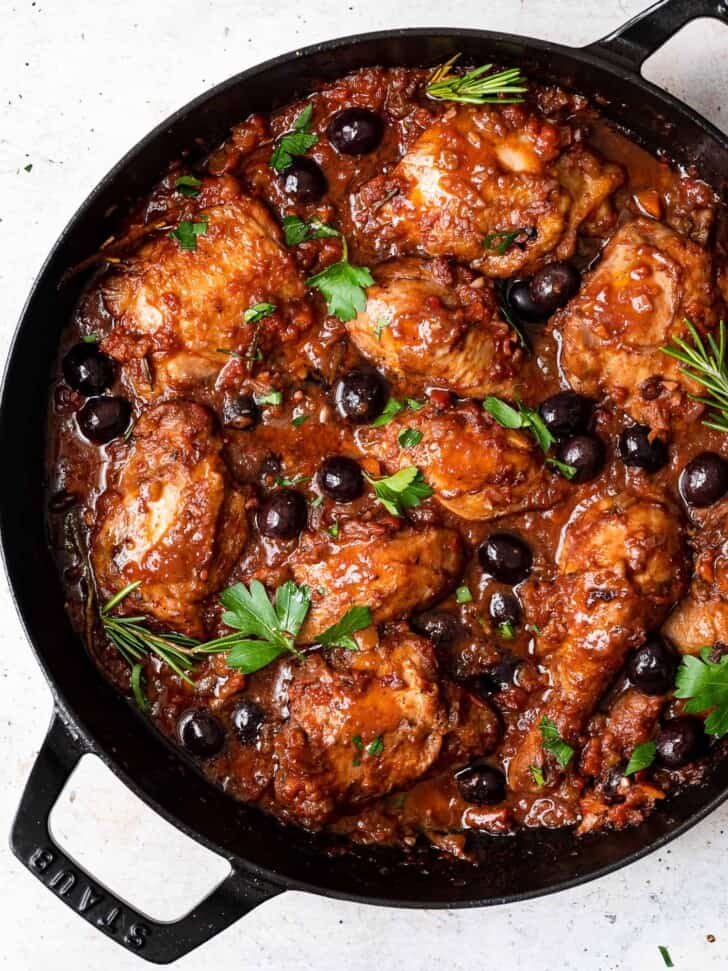

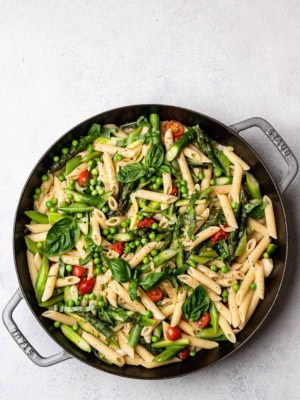

JoAnne
Sandra roughly how many pieces of chicken thighs would be 2lbs be?
Thanks 🙏🏻
Sandra Valvassori
Thanks for the question, Joanne. It’s a bit hard to say how many chicken thighs would be 2 lbs because some are so tiny and others are huge. If they are regular size (sort of medium-sized) I would think 8 chicken thighs. If they seem small, you can use about 10. If you buy them in a package, they will show the total weight which will help you gage. Hope that helps!
Gena
Not at all what I expected. Too much vinegar and I’m a vinegar lover
Sandra Valvassori
Hi Gena, I appreciate your feedback and I’m very sorry to hear you didn’t enjoy the dish. The vinegar flavour in chicken adobo is definitely supposed to be punchy but if the sauce is cooked down as the recipe instructs, the flavours mellow and become beautifully balanced. Would you mind letting me know which vinegar you used?
Dollface
In Hawai’i, none of our Filipinos add sugar to our adobo. Weird. I’m scared to try it and ruin the taste I know and love.
Sandra Valvassori
Hi! I completely understand your concerns regarding the sugar but note that the recipe calls for only 2 teaspoons of sugar which is a minimal amount. It does not make the dish sweet at all. Also note that the sugar is only supposed to be added if you can’t find Filipino cane vinegar. Please come back and let us know if you give it a try, your feedback would be very appreciated!
Anthony
Wow – I could eat this all day
Sandra Valvassori
So happy to hear this – so could I! Thank you for sharing, Anthony 🙂
Maribelle
It’s nice to read your enthusiasm about our dish. I usually make adobo when inspiration is lacking, as the dish is really easy. Sugar is indeed not necessary, but really works well when the vinegar is too strong. That being said, the Visayan dish Humba is very similar to Adobo, but uses sugar, and it is a staple dish during huge feasts in the region.
Sandra Valvassori
Hi Maribelle, thank you for sharing your thoughts on adobo chicken with us. Humba sounds like a lovely dish as well, I will have to give it a try 😊
Marian
Thank you Sandra – just reading and seeing your pics remind me of the chicken adobo that we have in the Philippines where I grew up. You would make any Filipino “nanay” proud! I’m glad that today (March 15) is Filipino Adobo Day in the Google doodle – I terribly miss it. I may try the tofu adobo that you shared here. 🙂
Sandra Valvassori
Hi Marian, thank you so much for your kinds words! It truly means a lot. That is really cool that Google doodle had a Filipino adobo day – such a beautiful, delicious dish sure deserved the spotlight. If you make the tofu adobo, make sure to use a smaller amount of vinegar and soy sauce. Would love to hear how it goes!
Kim
I assumed the bay leaves go in once you add the leftover marinade to the onions and garlic. I reread the recipe but couldn’t find it. It may be just me, though. Thanks for a great recipe!
Sandra Valvassori
Hi Kim, yes you add the bay leaves along with the leftover marinade. The instructions to add the bay leaves are in the recipe card (step #4) but I did forget to add them in the instructions written out in the blog post. Thank you for letting me know (fixed now!). So happy to hear you enjoyed the dish 😊
Hitesh
very nice amazing recipes thanks
Sandra Valvassori
Thank you Hitesh!😊
Lizettee
I just stumbled on your page looking up rice berry. I am Filipino and this is exactly how I make my adobo except for the onions. 🙂 I cannot wait to try your other recipes especially your Chicken Marsala.
Sandra Valvassori
Oh it makes me so happy to hear that this is how you make your adobo also, Lizettee! The onions are definitely not a traditional ingredient in adobo but they add just a bit of sweetness and depth of flavour. Let me know if you give it a try! I think you will also love the chicken marsala – it’s one of my absolute favourite dishes 😊
Karina
This was delicious! I did have to modify some #1-I didn’t use peppercorn and replaced with a pinch of ground black pepper. #2-Added 1/2 c of water to reduce the vinegar flavor #3- Added 1/4c more of soy sauce. Let the chicken sit in the sauce and cook down about 45min, flipping them halfway at about 25 min. The sauce thickened on its own. *I had 12 Large thighs skinless bone in.
Sandra Valvassori
Happy to hear you enjoyed the adobo with your modifications, Karina! Thank you for taking the time to write ☺️
Alex
Great recipe. Taste just like the Adobe I had while in the Philippines. Thank’s for helping me find that great taste.
Sandra Valvassori
I’m so happy to hear this, Alex! Thank you so much for taking the time to leave such a kind review 😊